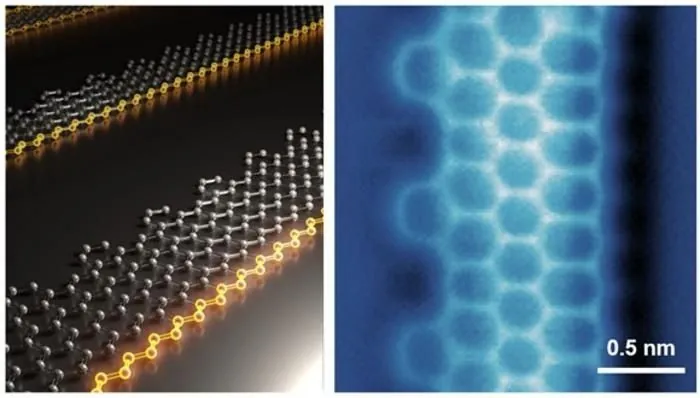
Revolutionary Janus Graphene Ribbons Set to Propel Quantum Technologies into the Future
2025-01-15
Author: Wei Ling
Introduction
In a groundbreaking advancement in material science, a team of researchers from the National University of Singapore (NUS) has unveiled a novel class of graphene nanoribbons (GNR), termed Janus Graphene Nanoribbons (JGNR). This innovative material features a distinct zigzag edge, which houses a special ferromagnetic edge state, setting the stage for the development of one-dimensional ferromagnetic spin chains. These spin chains could play a crucial role in the realms of quantum electronics and computing.
Research Collaboration
The research, led by Associate Professor Lu Jiong from NUS's Department of Chemistry, showcases a collaboration with esteemed international partners, including experts from UC Berkeley and Kyoto University. The findings highlight the incredible potential of Janus GNRs, given their unique properties that could revolutionize the field of quantum technologies by enabling long spin coherence times—essential for maintaining the integrity of quantum information.
Properties of Graphene Nanoribbons
Graphene nanoribbons, composed of nanoscale carbon structures arranged in a honeycomb lattice, exhibit fascinating magnetic characteristics due to unpaired electrons in their π-orbitals. By precisely engineering these structures into a zigzag formation, researchers can establish one-dimensional, spin-polarized channels. These channels are ideal for applications in spintronic devices and next-generation multi-qubit systems—the critical components of quantum computing technology.
Significance of Janus
The term 'Janus' references the Roman god associated with beginnings and endings, often depicted with two faces looking in opposite directions. In materials science, Janus materials refer to substances that exhibit differing properties on either side. In the case of JGNRs, only one edge displays the zigzag configuration, making it the world’s first known one-dimensional ferromagnetic carbon chain. This extraordinary design was achieved through a Z-shaped precursor strategy, introducing a pattern of hexagonal carbon rings that disrupts the symmetry of the ribbon.
Professor Lu's Remarks
Professor Lu remarked on the tremendous significance of this breakthrough, stating, 'The creation of magnetic graphene nanoribbons—formed from fused benzene rings—marks a significant step forward for quantum technologies. Their capacity to function at room temperature, coupled with enhanced spin coherence, offers new avenues for assembling multiple spin qubits necessary for these advanced applications.'
Synthesis Process
The successful synthesis of JGNRs was accomplished through the development of special ‘Z-shape’ molecular precursors, which were subsequently transformed via on-surface synthesis—an innovative chemical method requiring an ultra-clean environment. This process allowed the researchers to tailor the shape and configuration of the nanoribbons with atomic precision.
Z-shape Design
By fine-tuning the Z-shape design, the researchers were able to independently modify one edge while preserving the other, effectively creating desired ‘defective’ edges. The resulting JGNRs exhibit a ferromagnetic ground state localized along the zigzag edge, a critical feature confirmed through state-of-the-art scanning probe microscopy and density functional theory.
Future Implications
'The strategic design and execution of this pioneering class of Janus Graphene Nanoribbons not only set the stage for new discoveries in exotic quantum magnetism but also paves the way for the engineering of robust spin arrays,' added Professor Lu. 'The ability to create one-dimensional spin-polarized transport channels with adjustable bandgaps is poised to advance the field of carbon-based spintronics to the next level.'
Conclusion
With this remarkable achievement having been published in the prestigious scientific journal *Nature*, the implications of this research stretch far beyond academia. As quantum technologies continue to evolve, the introduction of Janus GNRs could lead to significant breakthroughs, enhancing computational power and efficiency in the not-so-distant future. This transformative development has positioned Singapore at the forefront of quantum innovation, promising to alter the landscape of technology as we know it.

 Brasil (PT)
Brasil (PT)
 Canada (EN)
Canada (EN)
 Chile (ES)
Chile (ES)
 Česko (CS)
Česko (CS)
 대한민국 (KO)
대한민국 (KO)
 España (ES)
España (ES)
 France (FR)
France (FR)
 Hong Kong (EN)
Hong Kong (EN)
 Italia (IT)
Italia (IT)
 日本 (JA)
日本 (JA)
 Magyarország (HU)
Magyarország (HU)
 Norge (NO)
Norge (NO)
 Polska (PL)
Polska (PL)
 Schweiz (DE)
Schweiz (DE)
 Singapore (EN)
Singapore (EN)
 Sverige (SV)
Sverige (SV)
 Suomi (FI)
Suomi (FI)
 Türkiye (TR)
Türkiye (TR)
 الإمارات العربية المتحدة (AR)
الإمارات العربية المتحدة (AR)